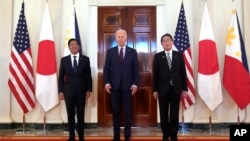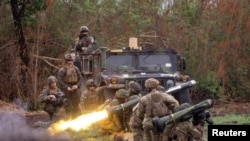For decades, U.S. policy in Asia has relied on what was informally known as the “hub and spokes” system of bilateral alliances. But lately, U.S. officials have used another analogy to describe their vision for the region: a lattice fence.
It may sound like only a metaphorical tweak, but officials in the administration of U.S. President Joe Biden say it could have big implications, as they try to create a durable plan to respond to China's growing power.
Under the old framework, the United States, the global military superpower, acted as the hub and its Asian allies, such as Japan, South Korea, and the Philippines, served as spokes.
Spokes are not linked to each other. But that dynamic is changing, as several major U.S. allies and partners coalesce around what they have come to call a “free and open Indo-Pacific.”
What U.S. officials envision is not a multilateral treaty alliance like NATO. Analysts have long said such a security framework is impossible in Asia, given competing interests and deep historical animosities, even among U.S. allies.
Instead, the goal is to help create an expanding number of mutually reinforcing links between like-minded countries, which together form a barrier – or in other words, a lattice.
Trilateral summit
The lattice strategy was on display last week, when Biden hosted Japanese Prime Minister Fumio Kishida and Philippine President Ferdinand Marcos Jr. for their countries’ first ever trilateral summit.
The meeting had important symbolic value. A joint statement expressed “serious concerns” about China’s behavior in the East and South China Seas, where China is trying to push its territorial claims over those of Japan and the Philippines.
The United States and Japan also pledged further assistance for the Philippines’ military modernization efforts and vowed to continue expanding joint military drills in the region, which have involved a growing number of partners in recent years.
At a separate meeting between Biden and Kishida, the United States and Japan announced dozens of bilateral deals related to defense cooperation, including plans to allow U.S. and Japanese forces to work more closely during a potential conflict.
According to a U.S. administration official who spoke to reporters during a background briefing, the meetings are evidence that Biden’s Asia plan is working.
“(Biden’s) theory of case was that if the United States reinvested in its alliances and partnerships in the Indo-Pacific … those allies and partners would step up alongside in ways that made us much better equipped to accomplish our objectives,” the U.S. official said.
Nowhere is this theory better proven, the official added, than in the U.S. alliance with Japan, where Kishida “has stepped up and stepped out into the world more than anyone really could have imagined.”
Japan a key player
As Japan loosens its self-imposed pacifist restraints, the country has become a major player in regional security. Japan has dramatically increased defense spending, moved to acquire missiles that can hit other countries, and enacted legal changes allowing it to more easily export weapons.
Japan is now heavily involved in many U.S.-led forums, including the Quadrilateral Security Dialogue, an informal coalition that also includes Australia and India, and the Group of Seven advanced economies, which has increasingly focused on China.
Last week, Britain, the United States, and Australia announced they are considering cooperation with Japan through their AUKUS security pact. NATO, the European military alliance, has also expanded cooperation with Japan, South Korea, Australia, and New Zealand.
“Today’s Japan is no longer the timid and inward-looking nation that counted on its embrace of pacifism and on American muscle to insulate it from external threats,” said Daniel Russel, a vice president at the Asia Society and a former top Asia official at the State Department.
One of the most crucial regional developments is the improvement of Japan-South Korea relations, which have long been strained because of issues related to Japan’s colonial occupation of Korea. Under South Korean President Yoon Suk Yeol, the two countries now regularly participate in military drills with the United States. Last year, the three countries unveiled a new system for sharing North Korean missile warning data in real-time.
But will it work?
Few observers deny that big changes are occurring, as countries respond to a more powerful China. But the strategic shift toward the United States is far from unanimous.
“Most governments in the region are hedging, recognizing the reality that China is a permanent and central feature of (the) Asian political economy,” said Van Jackson, who teaches at New Zealand’s Victoria University of Wellington.
According to a survey released this month by the Singapore-based ISEAS-Yusof Ishak Institute, Southeast Asian perceptions of the United States have worsened over the past year.
The State of Southeast Asia survey asks the same questions every year to a group of experts and government officials.
More than half, 51%, of Southeast Asian respondents said they would side with China over the United States if they were forced to choose. It is the first time that the survey has shown a preference for China.
One of the key complaints, according to the poll, is skepticism about U.S. economic engagement. Following then-President Donald Trump’s 2017 withdrawal from the Trans-Pacific Partnership free trade agreement, many in Asia have questioned whether the United States is as committed as it once was to free trade.
Biden officials dispute that notion, touting the Indo-Pacific Economic Framework or IPEF, as a counterweight to China's economic clout. But IPEF differs from traditional free trade deals in that it does not provide greater market access or reduce tariffs — areas no longer seen as safe in a U.S. domestic political context. Regardless, Trump has vowed to kill IPEF if he defeats Biden in November’s presidential election.
In the opinion of Philip Turner, a former New Zealand diplomat, IPEF appears to have largely failed.
“Many Asian countries and regional players like Australia and New Zealand have pointed out that the U.S. failure to commit economically to the region undercuts its claims to regional leadership,” said Turner, who most recently served as New Zealand’s ambassador to South Korea.
While there are increasing regional worries about China’s rise and behavior, few if any Asian countries support efforts to contain China’s growth, Turner added.
“They would prefer the U.S. climb down from its high horse of economic coercion against China and find ways of getting on with each other short of conflict,” he said.















